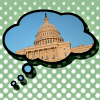Barack Obama recently e-mailed his legion of supporters — Democrats who gave up an e-mail address at some point during the 2008 campaign — to ask them to “commit” to vote in this fall’s midterm elections.
The president (or whoever writes the e-mails signed with his name) was, in the process, tapping into social science. Experimental research shows that when people say they intend to do something, they’re more likely to actually do it.
“This simple but powerful concept helped us make history in 2008, when first-time voters who made a commitment played a critical role in the election,” wrote the Organizing for America campaign in a follow-up e-mail.
This fall, volunteers are taking this strategy into communities across the country once again.
The Obama campaign notably leveraged the expertise of leading behavioral economists and social psychologists during the 2008 campaign (and the presence of such phrases as “studies have shown…” in the latest e-mails suggests they are likely doing so again).
But the challenge this time around is tougher, based on a few other insights into the psychology of voter turnout. True, asking people to set an intention can increase their likelihood of action. But people are also heavily influenced by what they think others are doing.
This means both parties this fall must figure out how to urge voters to show up without communicating that they’re at all worried about low turnout. Messages like “Midterm elections typically have low turnout, so it’s really important you vote,” may actually be perceived by people as, “No one is voting! So, I guess I shouldn’t either!”

Miller-McCune’s Washington correspondent Emily Badger follows the ideas informing, explaining and influencing government, from the local think tank circuit to academic research that shapes D.C. policy from afar.
“What the Obama administration is trying to do here is convey that this election is going to be important, and you need to vote, but it’s not, ‘Oh we’re panicking!'” said Notre Dame political scientist David Nickerson. “Couching this in terms of research might be a pretty savvy way to do that.”
Social scientists have identified similar behavior with recycling and home weatherization programs. Tell people others are recycling — “everyone’s doing it!” — and they’re more likely to want to conform to the social norm. This concept may be counterintuitive for advocacy groups that want individuals to pick up the slack for their socially irresponsible neighbors.
“Think about what would be the world’s worst charitable-giving slogan: ‘We’re in dire straights, and we’re going to go bankrupt if you don’t give to us,'” Nickerson said. “The average person says, ‘If my radio station is going to go out of business if I don’t give 50 bucks, it’s a lost cause.’ Campaigns need to convey, ‘We will be successful, this isn’t just you, there’s other people sharing the load.’ As in, This fall, volunteers are taking this strategy into communities across the country once again.”
Or, in an even stronger example of clever messaging from the 2008 campaign: “A record turnout is expected!”
Accepting this counsel may not have been universal across the White House, as the press secretary showed when he predicted the Democrats might lose control of Congress this November.
The study of voter turnout psychology is a relatively recent field. Even more recent — just in the last couple of years — is the embrace of such research by professional political organizers.
“Trying to get groups to do this, it was like pulling teeth,” Nickerson said of his own work on the topic in the early 2000s. “No one wanted to hear what we had to say — ‘What would academics tell us that we don’t know already? We’ve done this for many years. We know what we’re doing.'”
Now, Organizing for America may well want to look at another study published earlier this year by Nickerson and Harvard researcher Todd Rogers. They asked potential voters in Pennsylvania in 2008 not just if they intended to vote, but how exactly they planned to do so: What time would they go? Where would they be coming from? How did they plan to get there?
The researchers found that simply asking people if they intended to vote had little effect. But encouraging voters to map out a plan for when and how they would vote increased turnout by as much as 9 percentage points in households with a single eligible voter.
Obama would be wise, then, to check back in on all his commitments between now and November.





